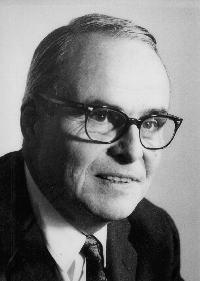Albert W. Tucker
| Albert W. Tucker | |
|---|---|
|
Albert William Tucker | |
| Born |
28 November 1905 Oshawa, Ontario, Canada |
| Died |
25 January 1995 (aged 89) Hightstown, New Jersey, U.S. |
| Residence | U.S. |
| Nationality |
Canadian American |
| Fields |
Mathematician: Combinatorial topology Optimization |
| Institutions | Princeton University |
| Alma mater | University of Toronto, Princeton University |
| Doctoral advisor | Solomon Lefschetz |
| Doctoral students |
David Gale John R. Isbell Marvin Minsky John Forbes Nash Torrence Parsons Lloyd Shapley |
| Known for |
Prisoner's dilemma Karush–Kuhn–Tucker conditions Combinatorial linear algebra |
| Influenced |
Harold W. Kuhn David Gale R. Tyrrell Rockafellar |
| Notable awards | John von Neumann Theory Prize (1980) |
Albert William Tucker (28 November 1905 – 25 January 1995) was a Canadian mathematician who made important contributions in topology, game theory, and non-linear programming.[1]
Biography
Albert Tucker was born in Oshawa, Ontario, Canada, and earned his B.A. at the University of Toronto in 1928 and his M.A. at the same institution in 1929.[2] In 1932, he earned his Ph.D. at Princeton University under the supervision of Solomon Lefschetz, with a dissertation entitled An Abstract Approach to Manifolds. In 1932–33 he was a National Research Fellow at Cambridge, Harvard, and the University of Chicago.
He then returned to Princeton to join the faculty in 1933, where he stayed till 1974. He chaired the mathematics department for about twenty years, one of the longest tenures. His extensive relationships within the field made him a great source for oral histories of the mathematics community.
His Ph.D. students include Michel Balinski, David Gale, Alan Goldman, John Isbell, Stephen Maurer, Turing Award winner Marvin Minsky, Nobel Prize winner John Nash, Torrence Parsons, Nobel Prize winner Lloyd Shapley, Robert Singleton, and Marjorie Stein. Tucker advised and collaborated with Harold W. Kuhn on a number of papers and models.
In 1950, Albert Tucker gave the name and interpretation "prisoner's dilemma" to Merrill M. Flood and Melvin Dresher's model of cooperation and conflict, resulting in the most well-known game theoretic paradox. He is also well known for the Karush–Kuhn–Tucker conditions, a basic result in non-linear programming, which was published in conference proceedings, rather than in a journal.
In the 1960s, he was heavily involved in mathematics education, as chair of the AP Calculus committee for the College Board (1960–1963), through work with the Committee on the Undergraduate Program in Mathematics (CUPM) of the MAA (he was president of the MAA in 1961–1962), and through many NSF summer workshops for high school and college teachers.
In the early 1980s, Tucker recruited Princeton history professor Charles Gillispie to help him set up an oral history project to preserve stories about the Princeton mathematical community in the 1930s. With funding from the Sloan Foundation, this project later expanded its scope. Among those who shared their memories of such figures as Einstein, von Neumann, and Gödel were computer pioneer Herman Goldstine and Nobel laureates John Bardeen and Eugene Wigner.
Albert Tucker noticed the leadership ability and talent of a young mathematics graduate student named John G. Kemeny, whose hiring Tucker suggested to Dartmouth College. Following Tucker's advice, Dartmouth recruited Kemeny, who became Chair of the Mathematics Department and later College President. Years later, Dartmouth College recognized Albert Tucker with an honorary degree. Tucker died in Hightstown, N.J. in 1995 at age 89. His sons, Alan Tucker and Thomas W. Tucker, and his grandson Thomas J. Tucker are all also professional mathematicians.
Works
- with Evar Nering: Linear Programs and related problems, Academic Press 1993
- with H. W. Kuhn (eds.): Contributions to the theory of games, Annals of Mathematical Studies 1950
- with H. W. Kuhn (eds.): Linear inequalities and related systems, Annals of Mathematical Studies 1956
- with Allan Gewirtz, Harry Sitomer: Constructive linear algebra, Englewood Cliffs 1974
References
- ↑ Cervone, Barbara Tucker; Duren, Bill; Kohn, J. J.; Snell, J. Laurie; Stein, Marjorie L. (1995), "A. W. Tucker: some reminiscences", Notices of the American Mathematical Society, 42 (10): 1143–1147, MR 1350012
- ↑ Gass, Saul I. (2011). "Albert W. Tucker". Profiles in Operations Research. International Series in Operations Research & Management Science. 147. pp. 95–11. doi:10.1007/978-1-4419-6281-2_6. ISBN 978-1-4419-6280-5.
Further reading
- Nasar, Sylvia (January 27, 1995). "Albert W. Tucker, 89, Pioneering Mathematician". New York Times.
- O'Connor, John J.; Robertson, Edmund F., "Albert Tucker", MacTutor History of Mathematics archive, University of St Andrews.
External links
- News from PRINCETON UNIVERSITY
- Albert W. Tucker at the Mathematics Genealogy Project
- A Guide to Albert William Tucker Papers
- Extract from an obituary
- Kuhn Tucker conditions
- The Princeton Mathematics Community in the 1930s An oral history project initiated by Tucker, also contains a series of interviews with Tucker.
- Oral History Interview with Albert W. Tucker, Charles Babbage Institute, University of Minnesota.
- Biography of Albert W. Tucker from the Institute for Operations Research and the Management Sciences
| Academic offices | ||
|---|---|---|
| Preceded by Emil Artin |
Dod Professor of Mathematics at Princeton University 1954–1974 |
Succeeded by Elias Stein |
